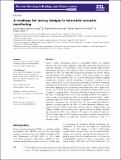Files in this item
A roadmap for survey designs in terrestrial acoustic monitoring
Item metadata
| dc.contributor.author | Sugai, Larissa Sayuri Moreira | |
| dc.contributor.author | Desjonquères, Camille | |
| dc.contributor.author | Silva, Thiago Sanna Freire | |
| dc.contributor.author | Llusia, Diego | |
| dc.date.accessioned | 2021-03-24T17:30:07Z | |
| dc.date.available | 2021-03-24T17:30:07Z | |
| dc.date.issued | 2020-09 | |
| dc.identifier | 272934546 | |
| dc.identifier | d99b39d6-6fca-4e03-848a-1a71b1b65223 | |
| dc.identifier | 85074988008 | |
| dc.identifier.citation | Sugai , L S M , Desjonquères , C , Silva , T S F & Llusia , D 2020 , ' A roadmap for survey designs in terrestrial acoustic monitoring ' , Remote Sensing in Ecology and Conservation , vol. 6 , no. 3 , pp. 220-235 . https://doi.org/10.1002/rse2.131 | en |
| dc.identifier.issn | 2056-3485 | |
| dc.identifier.uri | https://hdl.handle.net/10023/21710 | |
| dc.description | Funding: LSMS acknowledges doctoral fellowship #2015/25316‐6, São Paulo Research Foundation (FAPESP) and a Rufford Small Grant from The Rufford Foundation. TSFS received a research productivity grant (#310144/2015‐9) from the National Council of Technological and Scientific Development (CNPq) during part of this research. DL was supported by a postdoctoral grant (Atracción de Talento, 2016‐T2/AMB‐1722) granted by the Comunidad de Madrid (CAM, Spain) and acknowledges research project funded by the Ministerio de Economía, Industria y Competitividad (CGL2017‐88764‐R, MINECO/AEI/FEDER, Spain). | en |
| dc.description.abstract | Passive acoustic monitoring (PAM) is increasingly popular in ecological research and conservation programs, with high-volume and long-term data collection provided by automatized acoustic sensors offering unprecedented opportunities for faunal and ecosystem surveys. Practitioners and newcomers interested in PAM can easily find technical specifications for acoustic sensors and microphones, but guidelines on how to plan survey designs are largely scattered over the literature. Here, we (i) review spatial and temporal sampling designs used in passive acoustic monitoring, (ii) provide a synthesis of the crucial aspects of PAM survey design and (iii) propose a workflow to optimize recording autonomy and recording schedules. From 1992 to 2018, most of the 460 studies applying PAM in terrestrial environments have used a single recorder per site, covered broad spatial scales and rotated recorders between sites to optimize sampling effort. Continuous recording of specific diel periods was the main recording procedure used. When recording schedules were applied, a larger number of recordings per hour was generally associated with a smaller recording length. For PAM survey design, we proposed to (i) estimate memory/battery autonomy and associated costs, (ii) assess signal detectability to optimize recording schedules in order to recover maximum biological information and (iii) evaluate cost-benefit scenarios between sampling effort and budget to address potential biases from a given PAM survey design. Establishing standards for PAM data collection will improve the quality of inferences over the broad scope of PAM research and promote essential standardization for cross-scale research to understand long-term biodiversity trends in a changing world. | |
| dc.format.extent | 16 | |
| dc.format.extent | 3223228 | |
| dc.language.iso | eng | |
| dc.relation.ispartof | Remote Sensing in Ecology and Conservation | en |
| dc.subject | Acoustic monitoring | en |
| dc.subject | Acoustic recorders | en |
| dc.subject | Recording schedules | en |
| dc.subject | Recording settings | en |
| dc.subject | Temporal sampling | en |
| dc.subject | Wildlife survey | en |
| dc.subject | GC Oceanography | en |
| dc.subject | QH301 Biology | en |
| dc.subject | Ecology, Evolution, Behavior and Systematics | en |
| dc.subject | Computers in Earth Sciences | en |
| dc.subject | Ecology | en |
| dc.subject | Nature and Landscape Conservation | en |
| dc.subject | SDG 15 - Life on Land | en |
| dc.subject.lcc | GC | en |
| dc.subject.lcc | QH301 | en |
| dc.title | A roadmap for survey designs in terrestrial acoustic monitoring | en |
| dc.type | Journal item | en |
| dc.contributor.institution | University of St Andrews. School of Biology | en |
| dc.identifier.doi | 10.1002/rse2.131 | |
| dc.description.status | Peer reviewed | en |
This item appears in the following Collection(s)
Items in the St Andrews Research Repository are protected by copyright, with all rights reserved, unless otherwise indicated.

